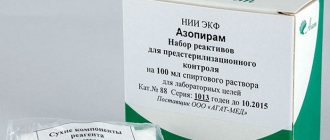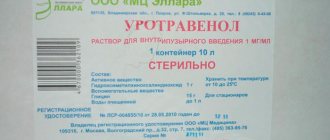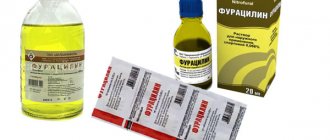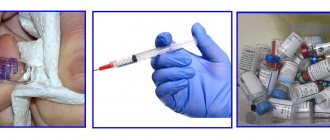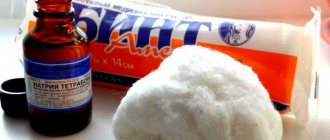Reagent for pre-sterilization cleaning of medical devices. "Service-Dis".
Packaging: 10g+100mg.
Azopyram "Service-Dis" Reagent for pre-sterilization cleaning of medical devices. | 76 RUR/pcs. |
Return to the section “Disinfection and sterilization”
AZOPYRAM Instructions for preparing 100 ml of AZOPYRAM solution for 500-1000 determinations, depending on the type of medical instrument Contents:
- Reagent No. 1 1 pc.;
- Reagent No. 2 1 pc.;
- Instructions for the preparation and use of Azopyram solution 1 pc.
Method of preparation: Pour both powders (No. 1 and No. 2) completely into a measuring container with a volume of 100 ml or more (for example, into a baby milk bottle or a bottle for saline solution). Pour 50-60 ml of 96-97% ethyl alcohol and stir until completely dissolved. Add 96-97% alcohol to the 100 ml mark.
Directions for use and dosage
When using Azopiram SK, the contents of the bottles with aniline and stabilizer are dissolved in 60 ml of 95% ethyl alcohol. The resulting mixture should be thoroughly stirred until completely dissolved.
The working solution of Azopyram, intended directly for checking the quality of cleaning of medical instruments, is prepared as follows: mix the drug and a solution of 3% hydrogen peroxide in equal proportions.
When using Azopyram Kit, no additional alcohol is needed. It is enough just to pour aniline into a bottle with amidopyrine solution.
According to the instructions, Azopyram should be checked for suitability before use. To do this, just apply 2 drops of the solution to the blood stain. If the stain turns pink-violet within a minute, the solution is ready for use. When checking a medical instrument for traces of rust and chlorine-containing oxidizers, a brownish rather than lilac color should appear.
According to the instructions, Azopyram is not suitable for use if no traces of staining appear after its use, or if it appears after a longer period of time.
All test products should be wiped with a swab soaked in Azopyram solution, or 2 drops of the solution should be applied directly to the product using a pipette.
When checking reusable syringes, you should take 3-4 drops of solution into them and move the plunger several times to wet the inner surface of the syringe with the solution. The reagent is left in the syringe for one minute, after which it is squeezed onto a napkin.
To check the quality of cleaning needles, the reagent is drawn into a syringe, and, sequentially changing the needles, pass the solution through each of them, squeezing a few drops of the solution onto a clean gauze napkin.
The cleaning performance of hollow products such as catheters is assessed by injecting reagents into the products. The solution is left in them for one minute, after which it is squeezed onto a gauze napkin. The amount of drug introduced into the product depends on its size.
As a rule, 1% of simultaneously processed medical instruments (at least 5 products) are subject to inspection.
After testing, regardless of the results, the remaining solution is removed from the products by rinsing them abundantly with water or wiping with a swab, and then pre-sterilization cleaning is repeated.
Indications for use
The kit is used to control the thoroughness of pre-sterilization cleaning of all medical instruments that come into contact with the wound surface, come into contact with blood or injectable drugs (for example, a set of operating instruments).
Azopyram-Kit is used on medical products to detect traces of:
- blood;
- rust;
- washing powder with bleaches;
- acids;
- oxidizing agents (in particular, chrome mixture, bleach, chloramine, etc.);
- peroxidases of plant origin.
Inspections are carried out at disinfection and sanitary-epidemiological stations, as well as in all medical and preventive institutions.
special instructions
Moderate yellowing of the kit reagents (without precipitation) does not in any way reduce its quality.
When checking medical instruments, they must be at room temperature. Do not test hot products, and do not use the solution near heating devices.
The working solution (Azopyram-Kit reagents + 3% hydrogen peroxide) should not be kept in bright light and can only be used for 2 hours.
The drug is able to retain its properties after freezing and subsequent thawing.
Carrying out a quality control reaction for pre-sterilization treatment of materials
The working solution (azopyram and 3% hydrogen peroxide in equal quantities are mixed before use) is used to treat the materials under study: wipe various surfaces with swabs soaked in the reagent, fill syringes, needles and other hollow objects with the solution, etc. In the presence of blood, immediately or no later than within one minute, the color appears, usually violet-blue at first, quickly turning into lilac-purple or brownish. The reagent detects the presence of hemoglobin, peroxidases of plant origin, strong oxidizing agents (chloramine, bleach, chrome mixture for treating dishes, washing powder with bleach, etc.), as well as rust and acids.
Azopyram kit, ready-made solution, 200 ml
Manufacturer: Russia Indications for use: According to the instructions, Azopyram is intended to detect traces of blood, acids, rust, chlorine oxidants, washing powder, plant residues on medical products in order to control the quality of their pre-sterilization cleaning in medical institutions, sanitary-epidemiological and disinfection stations. Medical instruments using Azopyram should be checked once a week. The contents of the bottle with aniline and stabilizer are dissolved in 60 ml of 95% ethyl alcohol, after which the volume of the solution is adjusted to 100 ml with ethyl alcohol. The resulting mixture is thoroughly mixed until completely dissolved. The Azopyram working solution, intended for direct testing of the quality of cleaning of medical equipment, is prepared as follows: equal parts of the drug and a 3% hydrogen peroxide solution are mixed.
When using Azopyram Kit, no additional alcohol is needed. Simply pour the aniline solution into a container with amidopyrine solution - and the drug will be ready for use.
Before using Azopyram working solution, a test for its suitability must be carried out. To do this, apply 2-3 drops of the solution to the bloody stain. If a pink-violet color of the spot appears within a minute, the reagent is considered suitable for use. If there are traces of rust and chlorine-containing oxidizers on the surfaces and objects being examined, a brownish rather than lilac color is observed. The instructions for Azopyram indicate that if coloring does not appear during a test test or appears after 1 minute, the solution cannot be used.
The test products are wiped with swabs soaked in Azopyram working solution, or a few drops of the reagent are applied directly to the product with a pipette.
When checking reusable syringes, take 3-4 drops of solution into them and move the piston several times to moisten the inner surface of the product with the reagent, especially the places where the glass comes into contact with the metal. The solution is left in the syringe for one minute, after which it is squeezed onto a napkin.
When checking the quality of needle cleaning, the drug is drawn into a clean, corrosion-free syringe. Consistently changing the needles, the reagent is passed through each of them, squeezing 2-3 drops onto a gauze pad.
The quality of cleaning of catheters and other hollow products is assessed by injecting Azopyram solution into the products. The reagent is left for 1 minute, after which it is poured onto a gauze pad. The amount of drug introduced into the product depends on its size.
As a rule, 1% of simultaneously processed instruments of the same type are subject to control (at least 3-5 products). After the procedure, regardless of its results, the remaining solution should be removed from the products by wiping them with a swab or rinsing them abundantly with water, and then repeat the pre-sterilization cleaning. Special instructions: Moderate yellowing of the kit reagents (without precipitation) does not in any way reduce its quality. When checking medical instruments, they should be at room temperature. Do not test hot products, and do not use the solution near heating devices. The working solution (Azopyram-Kit reagents + 3% hydrogen peroxide) should not be kept in bright light and can only be used for 2 hours. The drug is able to retain its properties after freezing and subsequent thawing.
DEZlikbez. Issue 9. Azopyram test
Friends, we have made another useful video for you about the azopyram test. It is without sound, so it is equally important to watch the video and read the text below.
If you have any questions, be sure to ask in the comments.
What is an azopyram test?
This is a way to check the quality of pre-sterilization cleaning (PSC) of instruments. Simply put, we check whether traces of blood and biological fluids remain on the instruments even after PSO.
If the instrument is not cleaned properly, the azopyram working solution will turn purple. If PSO is carried out well, the solution will not change color.
Who needs to know this?
Cosmetologists, manicurists and pedicurists and, of course, workers in medical institutions. Anyone who, when working with tools, can damage the client’s skin.
How to conduct a test correctly?
Step 1. Preparation of the working solution.
There are two options.
The first is the preparation of an azopyram sample from dry reagents.
To do this, you need to mix all the components of the reagent in the following proportions:
- amidopyrine – 100 g;
- analine hydrochloride – 1-1.5 g,
- Add ethyl alcohol 95% concentration to the required volume (about 1 l).
- Combine the resulting liquid with a 3% solution of hydrogen peroxide in equal proportions.
The finished liquid is called the working solution.
The solution is prepared immediately before testing and used within two hours after mixing the components. Otherwise, the sample efficiency will be zero.
If the reagent is stored in a room where the air temperature is above 25 degrees, it will turn pink faster.
The finished solution may turn yellow, this is acceptable if there is no sediment.
This solution preparation option is suitable for institutions that have a medical license and carry out medical activities.
According to SanPiN 2631-10, the use of alcohol is prohibited at public service enterprises, so you should use the second option.
The second option is to use a ready-made “Azopyram-Kit”.
This kit will greatly facilitate the preparation of an azopyram sample. The set contains only two bottles of reagents. The reagent from the small bottle must be poured into a large bottle. The result is a ready-made solution of azopyram.
Step 2. Adding hydrogen peroxide.
To perform an azopyram test, you will need 3% hydrogen peroxide.
Using a pipette, apply three drops of the prepared working solution of azopyram test and three drops of hydrogen peroxide onto a clean napkin.
Step 3. Testing.
We wipe the cutting elements of the instrument or those parts of it that come into contact with biological fluids or blood with a napkin. In the video, we took tweezers as an example.
If the tool has grooves or roughness (for example, cutters, and in our case it is a Uno spoon), the product is used in the form of drops. To do this, we will mix Azopyram with 3% hydrogen peroxide in equal parts and apply 2-3 drops to the instrument with a pipette. This is necessary so that the solution passes through all channels and joints of the tool parts.
After applying the product you need to wait 1 minute. During this time, the solution is allowed to drain onto a clean white napkin (this condition is one of the most important).
We will see the test results on a napkin in a minute. The result obtained after a longer time has no diagnostic value.
If the PSO was carried out poorly, and there are traces of blood or biological fluid on the instruments, after a minute a purple spot will appear on the napkin, and after a few seconds it will turn pinkish-blue.
If the stain on the napkin has a brown tint, it means there is rust or chlorine-containing oxidizers on the instruments. Pink color indicates the presence of detergents.
In our case, the reagent did not give positive results, so we believe that the instrument passed the PSA and there is no need to carry it out again.
To assess the quality of PSO, at least 1% of the instrument that has undergone a simultaneous cleaning procedure is taken. In the beauty industry, for a simpler count, at least three tools are taken from one batch.
How to check the suitability of a solution?
If the drug is stored for a long time, its suitability should be checked before use. Before making an azopyram test on the surface, 2-3 drops of the solution are applied to the blood stain. If within 60 seconds it turns purple, then the reagent is suitable for use. If coloring does not occur, then this solution cannot be used.
Several important rules for conducting an azopyram test:
- Coloring that occurs later than one minute after treatment is not taken into account when analyzing the results;
- The temperature of the instruments being examined must be at room temperature. Samples of hot objects are not allowed;
- Do not keep the working solution (with hydrogen peroxide) in bright light or in a room with high temperature;
- The Azopyram working solution must be used within two hours, the preparatory solution can be stored at room temperature for one month, in the refrigerator for two months.
- The container with the solution must be hermetically sealed and the glass must be dark.
- After testing, the remaining solution must be removed from the instrument, regardless of the result. To do this, items should be rinsed with water or wiped with a swab moistened with water or alcohol. After this, if necessary, repeat the pre-sterilization treatment or carry out sterilization.
- The results of all tests performed are recorded in a special PSO quality log. If the examination shows the presence of contamination, the entire batch of instruments must be reprocessed.
You can purchase “Azopyram-Komplekt”, as well as PSO quality control logs on our website.
In the video we showed how the azopyram test is performed.
Preparation of the Azopyram reagent
To start using the Azopyram reagent, it must be prepared. According to Azopyram's instructions, to prepare one liter of solution you need to take one hundred grams of amidopyrine and 1.0-1.5 grams of aniline hydrochloride. The Azopyram solution is brought to a volume of one liter by adding 95% ethyl alcohol. The resulting mixture of Azopyram and alcohol is thoroughly mixed until completely dissolved. To check the quality of cleaning of medical instruments, prepare a special working solution. It consists of equal parts of Azopyram and 3% hydrogen peroxide solution. According to the instructions for Azopyram, after preparation, a test is carried out to determine the suitability of the drug. In this case, two or three drops of Azopyram working solution are applied to the bloody spot. If within one minute the stain turns purple, then the reagent can be considered done correctly and suitable for use. If the stain does not turn purple, then the Azopyram solution has failed and cannot be used. If the stain turns color after more than one minute, then this Azopyram solution should also not be used.
